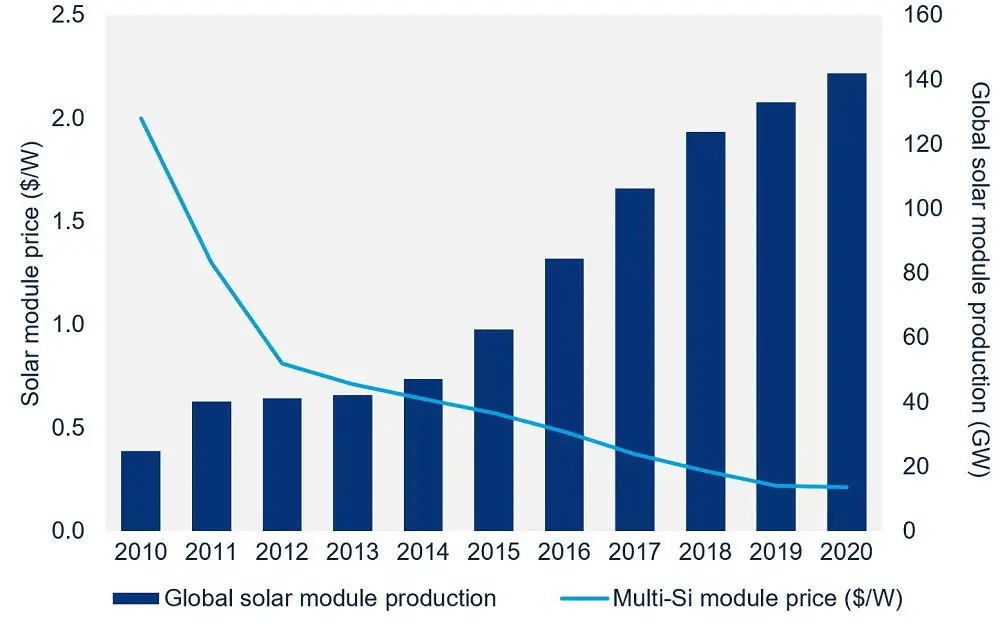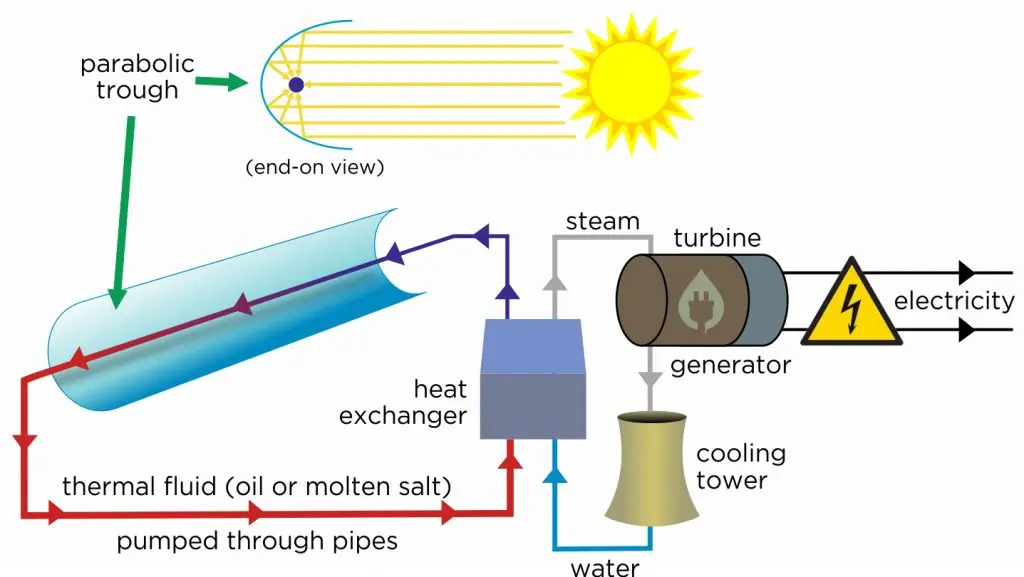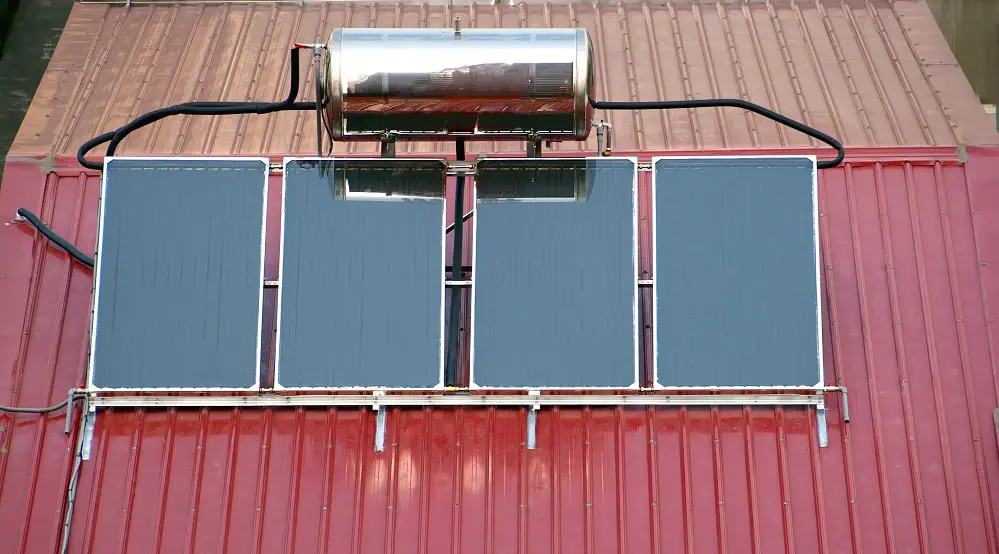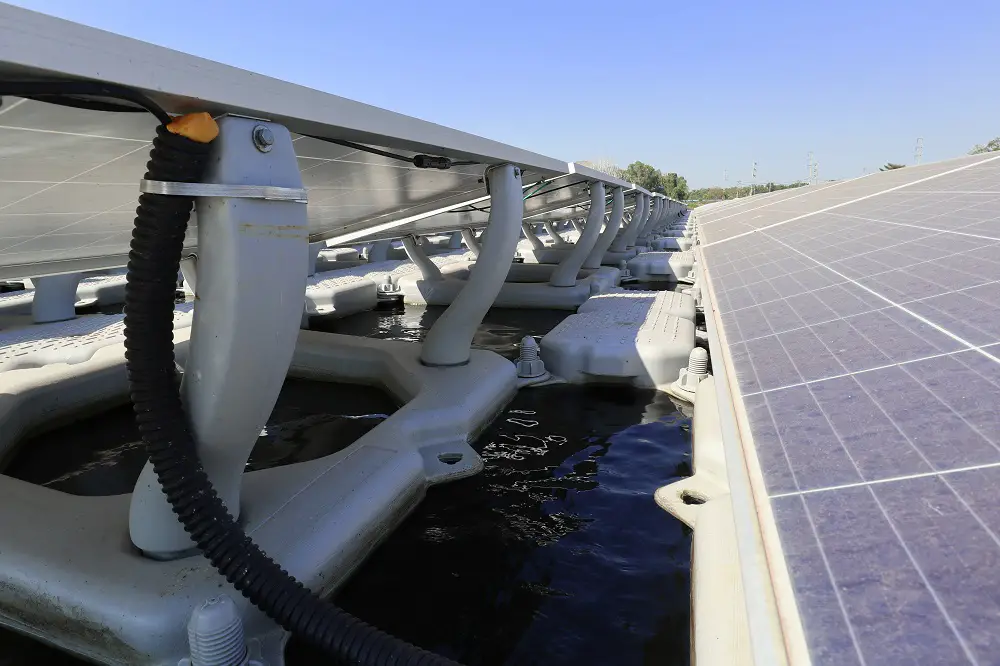Solar photovoltaics (PV), also known as solar cells, were invented in 1954 at Bell Telephone Laboratories in the United States [1]. Today PV is one of the fastest growing and cheapest forms of not only renewable energy but electricity production in general.
Solar can be used for a multitude of applications such as: microgrids to provide electricity to those far from the grid, solar thermal to heat the water for showering and cooking, concentrated solar power for large scale utility applications, floating solar arrays for manmade reservoirs, and PV for household or commercial use.

Types of Solar Energy and Their Applications
Installed solar capacity has been exponentially increasing since 2010, accounting for 39% of all new electricity generation in the United States during 2021 and surpassing wind energy for the first time [2]. The vast majority of installed solar is PV instead of solar thermal, 97% versus 3% respectively; This disparity is largely contributed to the 90% decrease in PV costs over the last decade as well as reduced battery storage cost as well.
Photovoltaics (PV)
Solar PV accounts for 3.1% of all global electricity generation and is the third largest renewable energy technology after wind and hydro [3]. Solar PV generation increased 23% in 2020 for a staggering total of 821 TWh. There is an anticipated fivefold increase of PV from 2020 to 2030 with China expected to provide 75% of all annual solar PV installations. In the United States, solar PV capacity increased 45% in 2020 to a total of 19 GW. Globally, the U.S. is the third largest market for PV [4].
Solar PV works by using a semiconductor material which creates free electrons that break out of their atomic bonds when activated by solar energy’s photons. These free electrons then travel through an electrical circuit in one direction (due to the semiconductor’s structure) and generate a flow of electricity.
Solar cells are limited in efficiency since only certain spectrums of light can be utilized. Also, a portion of light is either reflected, too weak, or lost as heat. Most solar panels have an efficiency of 15-20% with some monocrystalline panels reaching efficiencies of 23% [5].
The following factors affect the solar panel’s efficiency rating: material, wiring and busing, reflection, light wavelength/frequency, positioning and angle, temperature, climate, and shading. The efficiency is calculated by dividing the total wattage of the system by the product of the solar panel’s area times the concentration of light received to Earth [W/m2], all multiplied by 100.

The cost of manufacturing solar panels has plummeted dramatically in the last decade from $2/W to $0.25/W [6]. With a lifespan of 30 years, this renewable energy solution is not only affordable but also long-lasting with minimal maintenance required.
Concentrated Solar Power (CSP)
Concentrated Solar Power (CSP) converts the sunlight’s heat into electricity (unlike PV which converts the sun’s light into electricity). CSP uses mirrors to focus the sun’s heat at a single point (like a tower or parabolic trough - pictured below) which contains a heat-retaining fluid such as water, molten salts, or oil that produces steam to power turbines and thus generate electricity [7]. Most CSP projects in the United States are in the Southwest where there is the highest potential and concentration of solar power [4].
CSP used to be the dominate form of solar power until PV prices became more affordable [7]. CSP grew fifteen-fold between 2009 and 2020 with Spain and the United States leading the way [8]. Even with batteries, PV cannot provide the long-term duration storage that large power systems need and is capped at four-hour durations to be cost-effective in comparison to CSP which offers 12-24 hours of continuous power. It would also cost the United States $2.5 trillion to build a nationwide network of lithium-ion batteries, which would only last 2-3 years. In comparison, a molten salt storage tank for CSP will last up to 30 years and even then, it only requires a few months of maintenance to be up and running again.

"Renewables are now mainstream and fossil fuels are the alternative," said California Energy Commission (CEC) Chair David Hochschild.
In 2010, the United States had 0.4 GW of CSP and only 0.1 GW of utility-scale PV [7]. By 2020, CSP installations rose to 1.7 GW and utility-scale PV soared to 35.4 GW. Since 2014, CSP has struggled to compete with PV due to its higher price point and associated performance issues (such as Crescent Dune’s contract Nevada’s NV Energy being canceled in 2019 due to problems with molten salt storage system). As of 2019, there are 90 CSP plants worldwide providing 6,000 MW of capacity.
The first recorded instance of CSP technology being used was in Egypt in 1912 where farmers used solar to pump water into the desert with steam-powered turbines [8]. Currently in 2020, Dubai has a CSP tower project that powers 1.2 million homes, and its capacity is expected to grow five-fold by 2030. Early CSP projects had billions of dollars in capital costs and an average levelized cost of energy (LCOE) of $0.21/kWh yet this Dubai CSP with storage project reports an LCOE of only $0.083/kWh [7].
Towers have a greater efficiency over parabolic troughs since there is only a single pipe so there is less heat-loss. Tower designs are also cheaper as curved mirrors are expensive to produce. Additionally, the liquid medium for towers (molten salt) has a wider operable temperature range than oil and water used in parabolic troughs so the steam can be produced faster and in larger amounts.
One advantage with parabolic troughs, however, is the modular aspect the design provides by being able to add more loops to the system and gradually expand the plant’s capacity as demand grows. This factor is also very attractive to potential financial investors as it is a less risky investment and also takes less time to develop.
Solar Water Heating
Heating water accounts for 18% of a home’s energy use [9]. Solar-powered hot water can reduce a traditional home’s water heating bill by 50-80%. Solar water heating works by circulating water through a solar collector (such as flat-plate or tube) and then deposits the heated water in a storage tank to be used day or night. The system can also use a non-freezing fluid (like anti-freeze) for colder climates which then passes into a heat exchanger after the solar collector to heat up the water before the hot water going into the storage tank.

These systems can be active or passive with active requiring electricity to power the pumps or passive which uses gravity to naturally bring the water from higher ground to the faucet or shower. While passive systems are less costly, they are less efficient than active systems. Passive systems are also more reliable and last longer than active solar hot water systems.
Solar Cooling
Solar cooling converts heat from the sun into cooling by heating a refrigerant to generate pressure for air conditioning or refrigeration for food [10]. The refrigerant will transform through the process of evaporation from liquid to gas, absorbs the heat to cool the surrounding, and then returns back to a liquid again.
Applications for solar cooling include recreational vehicles (RVs) and vapor absorption refrigeration systems. Solar cooling is especially useful in hot climate countries with an abundance of sunshine that cannot afford the high costs of running conventional air conditioners or for off-grid applications such as hospitals in remote locations. Solar cooling is best suited for industrial use and not residential due to its high cost and low efficiency in small applications.
Solar Microgrids
Solar microgrids are off-grid systems that provide electricity to those either too far from the national grid (such as remote villages or islands) or for those who desire back-up power in case of an outage such as hospitals or telecom towers [12].
“Microgrids also help to improve grid resiliency and reliability, for instance during extreme weather events. In cities affected by frequent power cuts, they are a clean and efficient alternative to diesel generators, which are highly polluting and expensive to run, pushing up the cost of doing business,”
Maxine Ghavi
One example of a solar-powered microgrid is the Port of San Diego which received $5 million in grant funding (matched by the port of San Diego’s funding) for a microgrid with 700 kW of solar and 700 kW of storage [14]. This solar microgrid installed in 2020 allowed for the port to be open 24/7 which was essential during the cargo shipping congestion during the pandemic. The project is expected to reduce energy costs by a staggering 60%.
Another instance, Tesla, has over 120 operational microgrids worldwide powered by their Powerpack batteries and renewable energy [15]. Tesla’s first microgrid project was located on an island and partnered with SolarCity to produce a 1.4 MW of solar with 6 MW of storage from 60 of Tesla’s Powerpacks. This project provided 600 islanders with electricity and saved over 100,000 gallons of fuel annually which they had to expensively ship from off the island.
Floatovoltaics (FV)

Floating solar farms (or Floatovoltaics, FV) are used in conjunction with irrigation ponds, lakes, reservoirs and waste-water treatment centers [2]. These systems are a great way to utilize existing real-estate, and they also provide a benefit of using the surrounding water to cool the panels and thus increase their efficiency by 22 percent [16].
The systems are also advantageous for the reservoir as it prevents harmful algae blooms that cause sickness in humans and animals and vastly increase drinking water treatment costs. The panels also block sunlight from reaching the water thus reducing evaporation losses, which is important in drought-ridden places. These floating-voltaic systems cost less to install compared to traditional PV since there is no need to clear land or treat soil.
The National Renewable Energy Laboratory (NREL) estimates that if floatovoltaics were installed on just a quarter of all manmade reservoirs, they could generate 10% of the energy needs for the United States [16]. The world’s first floating solar system was installed in 2008 at a California winery.
Currently, there are 100 floatovoltaic installations worldwide with 80% of those in Japan. The largest floating solar array is located in China and powers up to 15,000 homes [17]. The solar system consists of 166,000 panels and has a capacity of 40 MW.

